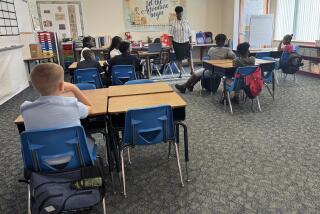EDUCATION : Black Mayor Urges End to Busing for Integration
MINNEAPOLIS — The city’s first black mayor last year uttered what to many seemed unthinkable.
Democrat Sharon Sayles Belton, in her State of the City Address, said that Minneapolis needed to “rethink” the $8 million it spends each year on school desegregation and whether the money should be redirected to student achievement.
“Every day, Minneapolis children are bused a total distance equal to a trip to the moon,” she said. “Perhaps they’d be better served if we spent the money on strategies that would get them, at age 18 or 21, not to the moon but to the door of a well-paying employer.”
Sayles Belton favors returning students to a combination of neighborhood schools and magnet schools, and tackling integration by desegregating neighborhoods.
For the first-term mayor, elected with the support of civil rights groups, the words were politically risky.
The National Assn. for the Advancement of Colored People has not publicly lambasted Sayles Belton, instead demanding that the courts do more to advance desegregation. In September, the group filed a lawsuit contending that the state has failed to provide Minneapolis students with a decent education and that it doesn’t enforce its desegregation rules.
“We’ve been at the table with the state Board of Education,” said Bill Davis, president of the Minneapolis NAACP. “We felt there was no movement. . . . We say that the school board talks the talk, but doesn’t walk the walk.”
Davis said that fears of large-scale busing are misplaced and that the suburbs can participate in desegregation without greatly expanding busing.
The NAACP has downplayed its differences with the mayor, saying their goals are the same. But the civil rights group is finding its position a lonely one.
In November, Republican state legislators called on the Board of Education to scrap work on a Minneapolis school desegregation plan in favor of neighborhood schools and voluntary desegregation efforts. But the board is moving ahead with plans for voluntary desegregation schemes in a handful of suburban districts. And in December, the Minneapolis school board endorsed plans to begin returning to neighborhood schools later this year.
Sayles Belton maintains the focus must shift to desegregating neighborhoods and building new jobs. “It does bother me that the NAACP has a different perspective. My parents were members of the NAACP and fought for busing.” But busing, she said, has never lived up to its promise of equality.
Studies show that more than two decades of busing have failed to erase lags in minority student achievement. In fact, the gap has increased.
The problem is not school segregation but the quality of education, said Minneapolis Supt. Peter Hutchinson. Desegregation rules focus on racial composition but not on how well students are doing, he said.
In Minneapolis schools, no single racial group makes up a majority. White and black students each total 39% of students, with Asians, Native Americans and Latinos making up the rest.
If students were reassigned to their nearest school, no school would have less than 35% minority students, Hutchinson said. Yet, about 95% of the district’s 45,000 students are transported about three miles a day in a city just five miles wide and 11 miles long.
While school district officials hope a state waiver will allow them to move ahead with their integration formula, the NAACP expects it to take up to five years to resolve its lawsuit.
More to Read
Sign up for Essential California
The most important California stories and recommendations in your inbox every morning.
You may occasionally receive promotional content from the Los Angeles Times.










